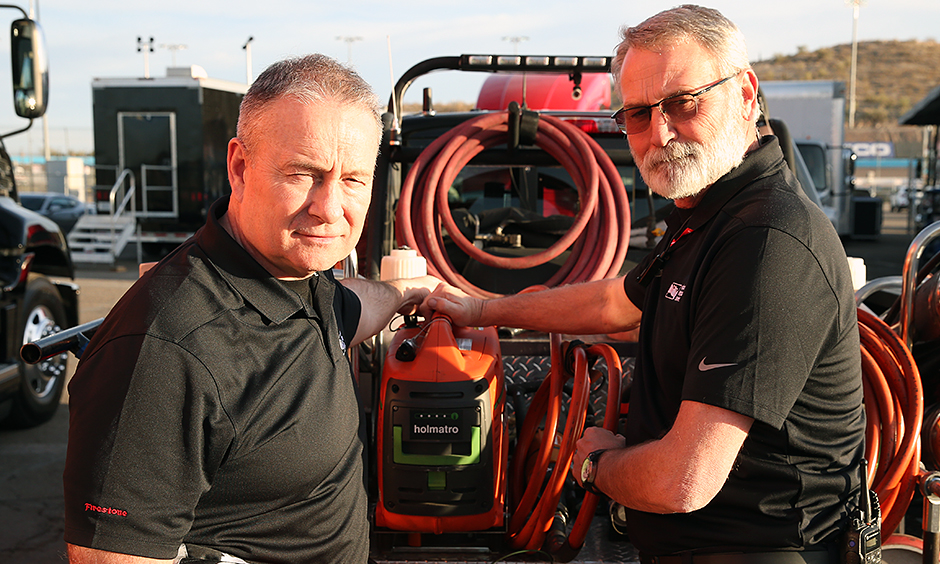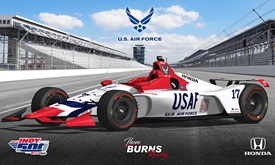New track safety manager Baughman has extensive leadership experience
MAR 07, 2018
Tim Baughman’s career as a firefighter with the Indianapolis Fire Department has more than prepared him for the latest chapter in his life.
Baughman, a member of the Indianapolis Motor Speedway track safety crew since 1982 and a member of INDYCAR’s safety team since its inception in 1996, takes on a new role as INDYCAR’s manager of track safety in 2018. In his role, Baughman manages the 30-person AMR INDYCAR Safety Team that travels to every Verizon IndyCar Series event to care for drivers, team personnel and fans at tracks.
“I started off as an EMT/paramedic at the track taking care of the fans in the infield,” said Baughman (at left in above photo). “I moved to the garage area, then pit road and then they asked me to be a member of the safety team in 1992. I started traveling when the (INDYCAR safety team was formed) in 1996 and worked my way up from the firefighter in the back of Safety 2 (on-track response pickup truck) to the primary paramedic in Safety 2. For the last seven or eight years, I’ve been the crew leader on Safety 2.”
Baughman’s at-track duties won’t change with his new role.
He’ll still be the crew leader of Safety 2, one of three on-track units utilized by INDYCAR around each racetrack. But he knows he has big shoes to fill as manager of track safety, replacing Mike Yates, an original team member who retired following the 2017 season. Yates and Baughman were also members of Indiana Task Force One, which responded to the World Trade Center after the Sept. 11 terror attacks in 2001.
“Prior to Mike, there was Dave Brown and Dr. (Henry) Bock and all the others,” Baughman said. “The cool thing was, although I am a few years behind Mike in age, I was at the track before Mike. We’ve been working in parallel for a long time. We go back a long way. We were partners 40 years ago on a medic truck. The racing bug definitely bit us both and we’ve been involved in it ever since.”
The change in leadership of the AMR INDYCAR Safety Team brings a new philosophy for the team’s members, many of whom are in leadership positions with their own departments away from the track.
Baughman, who has nearly 25 years of leadership in the Indianapolis Fire Department and will remain there as a fire chief until retirement, says his goal in leading the AMR INDYCAR Safety Team is to develop the talent around him, make each member more well-rounded and the entire unit stronger.
“It used to be that the young guys would have to earn their way up from the pits,” Baughman said. “We don’t have that much turnover, so we’ve asked the whole team to do more rotation this year so that everyone gets more well-rounded in what they’re doing.
“It’s a different approach. You’ll see new people driving Safety 1, Safety 2 and Safety 3. You’ll see different paramedics moving up into the seat to get exposure. You’ll see some of the older faces on pit road. That’s something new from me.”
A new Indy car for 2018 also brings a challenge for Baughman and the safety team, but that ability to adapt suits him in the new position.
“Trying to stay ahead of technology,” he said. “Like the windscreen testing (at Phoenix). We’ll get our chance to climb in and around the car (with the windscreen) and see what challenges it poses. Then we’ll make an assessment to see what we need to do to take care of it. We’ve been doing that for a long time. We get a new car or a change in the car or new tracks. Our job is to be resilient and stay with it.”
Baughman also knows team members will look to him as the sport evolves. But he also has good people around him including Jim Norman (at right in above photo), the fire dispatcher in Race Control, and crew leaders Mike Carey (Safety 1) and Doug Allen (Safety 3).
“Managing people, implementing new techniques and policies that work and are sound is a big part of this,” Baughman said. “That’s what makes the AMR INDYCAR Safety Team effective. We have great people. We have a great team. But it’s a system that starts long before we ever hit the track.
“It’s the doctors and nurses reaching out to the facility to make sure the trauma team is on site, that the (medical) helicopter is available. We do assessments of the facility about their resources and make sure when we get on the ground, we have procedures that serve the driver best when there’s a situation.”



















